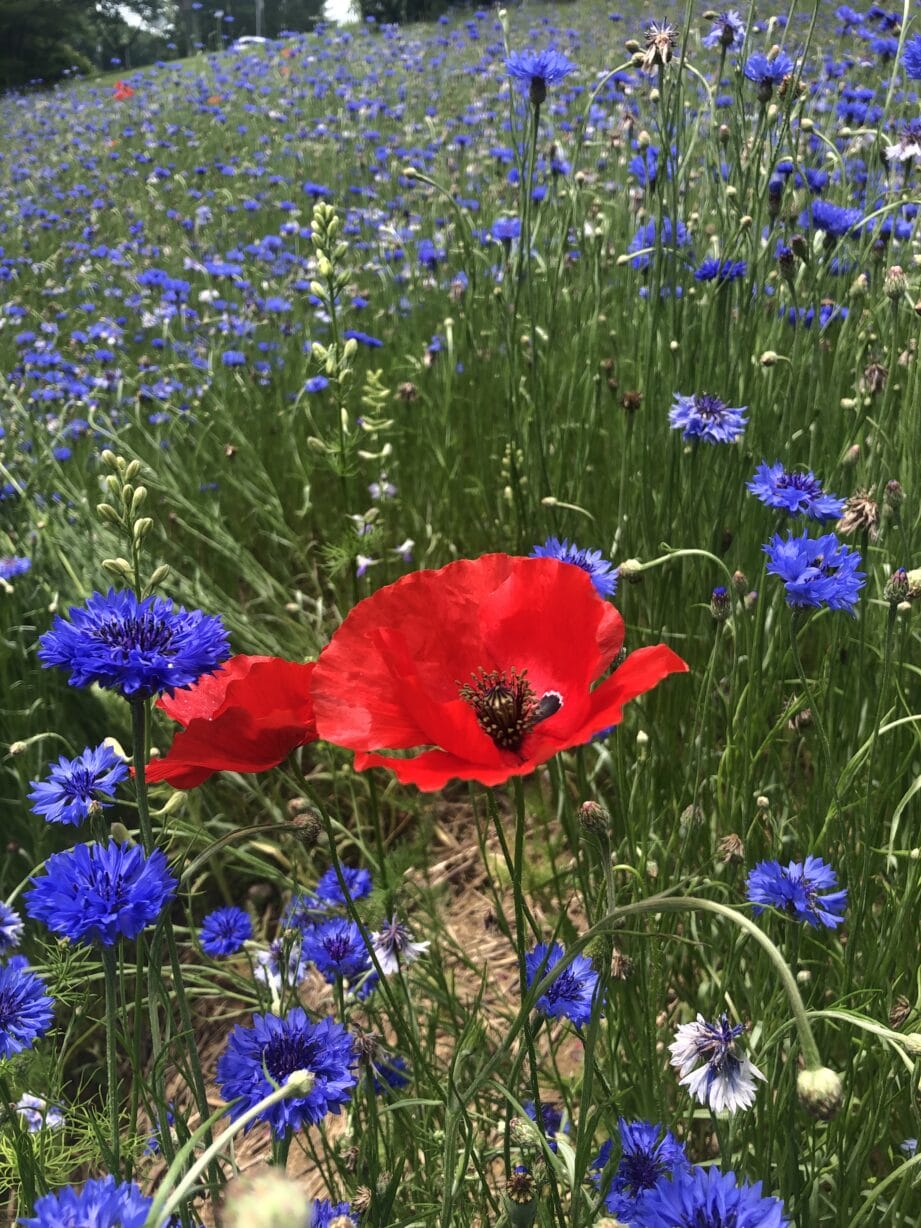
By Sofia Samatar
“The Friendly City” is a weekly column about walking in Harrisonburg that will run during 2024. Each week, your friendly correspondent, writer and teacher Sofia Samatar, will reflect on a walk in our city.
“What is natural about being human?” asks the poet Harryette Mullen. “What to make of a city dweller taking a ‘nature walk’ in a public park while listening to a podcast with ear-bud headphones? What of a poet who does not know the proper names of native and non-native fauna and flora, who sees ‘a yellow flower by the creek’—not a Mimulus?”
Mullen’s words imply a certain self-criticism, an embarrassment and melancholy at being an urban poet who doesn’t know the scientific terms for plants and animals, whose cyborg body is hooked up to plastic and silicon, whose “nature walk”—in self-deprecating quotation marks—hardly deserves the name. I’m thinking of this as I cross the street from the Friendly City’s large university, behind the recreation center, and enter a trail through the woods that will lead me to the arboretum.
I am a city walker like Mullen, equipped with a phone that takes photographs, an app that identifies plants, another that recognizes bird sounds. Without these technological supports, I wouldn’t be able to tell you that the brief, articulate whistle I hear in the depths of the leaves is a red-eyed vireo, or call the pimple-pink, coarsely furred wineberry by its name. Breathing the moist, verdant, shady air, waving off gnats, I walk through a space that’s like me: a hybrid of the biological and the artificial, the wild and the engineered. A wide gravel path welcomes the tread of my sneakers; between the hoary old trunks that plunge high into the sky, upholding a humid canopy, I glimpse wan strips of parking lot and the backyards of people who live near the trail: brick patios, sunlit deck chairs, pots of geraniums.
What is natural about being human? An orange post in the undergrowth blazes Warning: Buried Fiber Optic Cable. A gnomelike trashcan stands discreetly in the fallen leaves, its stout neck wrapped in a grandmotherly shawl of black plastic. Farther on, a field of tiny colored flags marks a work in progress, labeled by a nearby sign as a Native Shade Garden. This hybrid environment comes to a head in the arboretum, where a wooden bridge swings among trees tagged with nameplates, where the screeches of jays are interspersed with the shrieks of children playing around the giant mushroom statues in the green sunglow.
The humans are here, the young, the elderly, humans with walkers, humans with canes, in strollers, in backpacks, toddling unsteadily on little plump legs, bending to read the signs on the trees, crying out at the sight of a turtle, crouching to watch fish dart below the filmy surface of the pond. They gather in dense groups around the flowers. “Oh, look at this one!” they exclaim. “Look at that!” And what do the flowers say? How many people here have brushed up on their botanical Latin, how many are themselves gardeners with an intimate knowledge of growing things, how many are simply drawn to pink and blue, to a drooping whiteness, to a soft fragrance, as naturally as a swarm of bees?
I’ve brought along a little book that was given to me as a child: a glossary of the Victorian language of the flowers. Once, as I understand it, a certain refined, repressed, almost pathologically subtle subculture communicated through bouquets. Hearts were broken and engagements negotiated through combinations of color and scent, sometimes accompanied by restrained gestures, such as holding a nosegay upside-down or at the level of one’s heart. Paging through the book as I walk, I discover that the dogwood blooms, with their stiff, regular petals of white leather, are saying Durability. They are speaking, I think, of an endless love, because I can’t imagine a time when humans no longer prize, adore, cultivate, and gravitate toward flowers.
The peony says Bashfulness, nodding its oversized head, heavy with mortification and stained with blushes all over its hot cheeks. The haughty spiderwort announces Esteem not love, keeping suitors at a distance with long fastidious green fingers, cordial yet firm, drawing back its pinched purple face above an elaborate choker of jade beads. Rendezvous, says the impudent and mischievous chickweed, winking its agate eyes surrounded by starry white lashes. I laugh at this complex code from the past, finding it ridiculous that the rhododendron, its papery mauve flowers looking faint with heat, is supposed to be shouting Danger! Beware! And the mountain laurel—so familiar to me from hikes in the national forest it seems domestic and cheerful in its red-and-white gingham topped with a snowy apron—this companionable flower, I’m told, signifies Ambition.
But all our codes are arbitrary. Flowers have no proper names. For this magnificent iris, its mink collar splashed with overpoweringly sweet cologne, the word proposed by my little book—Flame—will do just as well as Iris germanica cultivars. Flowers are multilingual, speaking horticultural Latin to those who can understand it, addressing themselves to others with form and color. They say yellow. They murmur scent. They communicate through silken texture, irritating pollen, milky fluids, and thorns.
On the hillside, a field of bachelor’s buttons dazzles me with its lapis blue, the flowers upright on their stalks like proud, insouciant gallants at a ball, proclaiming Celibacy as if to remind me, with a merry glance, that they have their own way of life, which is not mine—while scattered among them, a few bold poppies raise their scarlet bowls, each smoldering vessel sprinkled with charred spices, bearing a message that applies equally to human language games and the brilliance of the more-than-human world: Fantastic Extravagance.













